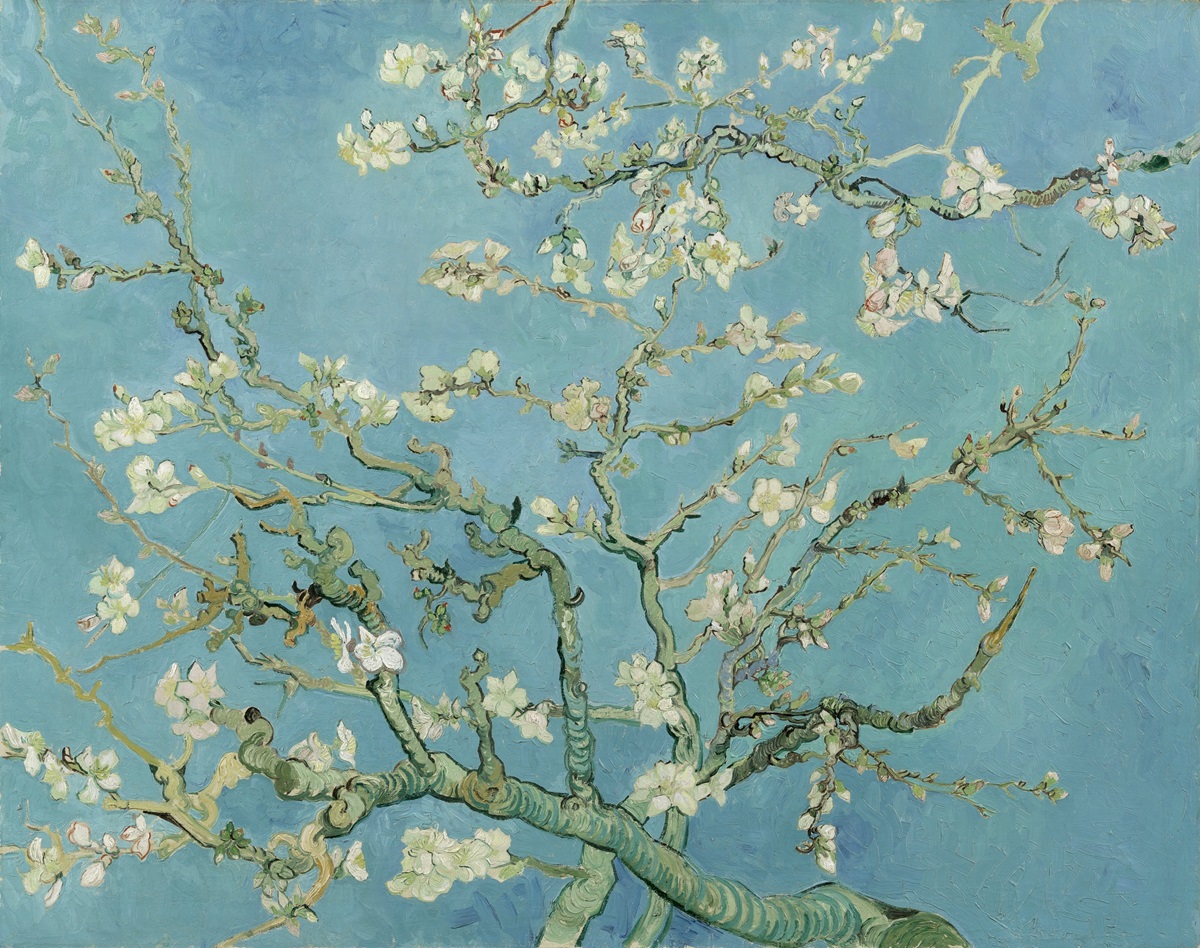Blossoming Almond Tree
By Vincent van Gogh, 1890
Blossoming Almond Tree: Vincent van Gogh’s Vibrant Ode to Renewal and Technical Mastery
Vincent van Gogh, a name synonymous with artistic brilliance and emotional depth, left an indelible mark on the world of art with his profound and expressive works. Among his many masterpieces, “Blossoming Almond Tree” emerges as a poignant and symbolic gem that invites viewers into the intricate world of the artist’s emotions and technical prowess. This article will delve into the technical challenges faced by van Gogh during its creation, its location, and its enduring legacy.
A Portrait of Vincent van Gogh’s Life
Before we explore the mesmerizing details of “Blossoming Almond Tree,” it is essential to step into the tumultuous life of Vincent van Gogh. Born in 1853 in the Netherlands, van Gogh’s existence was a turbulent blend of artistic passion, mental health struggles, and financial adversity. In a mere 37 years, he would create over 2,000 works of art, each brushstroke a testament to his indomitable spirit and unwavering commitment to his craft.
Van Gogh’s artistic journey began in earnest during his late twenties, and he quickly developed a distinctive style characterized by bold and expressive brushwork, intense color palettes, and a profound connection with his subjects. His art became a lifeline, a means of wrestling with his inner demons and exploring the complexities of the human experience.
Blossoming Almond Tree: An Allegory of Renewal
In February 1890, Vincent van Gogh painted “Blossoming Almond Tree” as a gift for his newborn nephew, Vincent Willem van Gogh, the son of his beloved brother Theo and sister-in-law Johanna. The painting stands as a triumphant celebration of life, renewal, and the enduring power of art to capture moments of profound significance.
The canvas explodes with a riot of colors, most notably dominated by vibrant blues and lush greens. Against this backdrop, an almond tree rises gracefully, its branches adorned with delicate blossoms in shades of white and pink. These blossoms seem to shimmer with an inner light, radiating vitality and energy that virtually leaps off the canvas.
“Blossoming Almond Tree” Large Canvas Prints from WhiteClouds
The Location
The choice of Saint-Rémy-de-Provence as the location for the creation of “Starry Night” is not incidental. The village and its surroundings provided van Gogh with a rich tapestry of inspiration. The landscapes of Provence, with their rolling hills, cypress trees, and starlit skies, served as a wellspring of creativity, infusing his work with the essence of the region.
The Composition
“Starry Night” presents itself as a picturesque French village beneath a celestial sky at first glance. However, it transcends the boundaries of reality, inviting viewers into a world where the ordinary converges with the surreal. The village, illuminated by warm, golden hues, seems to be both nestled beneath and consumed by the cosmic tumult swirling above, blurring the lines between the earthly and the ethereal.
The Starry Sky
Van Gogh’s interpretation of the night sky in “Starry Night” goes beyond mere representation. It is a profound emotional and spiritual expression, transcending astronomical accuracy. The sky is a swirling maelstrom of blues, deep indigos, and radiant yellows, a cosmic tempest with luminous stars and a crescent moon. The tumultuous swirls and bold strokes evoke a sense of cosmic turbulence and transcendence, encouraging viewers to lose themselves in the boundless expanse of the universe.
Technical Challenges and Triumphs
Van Gogh’s technical prowess comes to the forefront in “Blossoming Almond Tree.” To achieve the vibrant colors and lively textures that characterize the painting, he had to overcome several technical challenges. One significant hurdle was the viscosity of the oil paint he used, which can be difficult to control. Van Gogh’s masterful handling of the medium allowed him to create bold, textured brushstrokes that give the tree and blossoms their tactile quality.
Furthermore, the process of layering multiple colors to create depth and luminosity required precision and patience. Van Gogh’s dexterity in layering and blending pigments is evident in the nuanced gradations of color in the blossoms and leaves. This meticulous approach to color and texture is a testament to his technical mastery and dedication to his craft.
The Influence of Japanese Art: A Harmonious Fusion
One cannot fully appreciate “Blossoming Almond Tree” without acknowledging Vincent van Gogh’s profound fascination with Japanese art, specifically ukiyo-e woodblock prints. Van Gogh was an avid collector and a keen student of these prints, and their influence is unmistakable in his work.
In “Blossoming Almond Tree,” one can discern echoes of the flat, decorative quality that characterizes Japanese prints, as well as the pronounced outlines defining the tree’s branches. However, van Gogh’s appreciation for Japanese art transcended aesthetics. He absorbed the spiritual and emotional essence of these works, infusing his own creations with their profound sensibilities.
The Painting’s Enduring Legacy and Location
“Blossoming Almond Tree” endures as one of Vincent van Gogh’s most celebrated and cherished masterpieces. It currently resides in the Van Gogh Museum in Amsterdam, the city where the artist once lived and created many of his iconic works.
The Van Gogh Museum, located on Museumplein in Amsterdam, is a fitting home for this masterpiece. The museum houses the world’s most extensive collection of van Gogh’s works, providing visitors with a comprehensive understanding of the artist’s evolution and the enduring impact of his art. “Blossoming Almond Tree” is a highlight of the museum’s collection, captivating audiences from around the world with its message of renewal and hope.
Vincent van Gogh: A Tormented Genius
Vincent van Gogh’s life was a tapestry of brilliance and torment. His struggles with mental health, including bouts of depression and anxiety, cast a long shadow over his existence. Nevertheless, his determination to capture the beauty and essence of the world around him never wavered.
Van Gogh’s career as a painter began in earnest when he was in his late twenties, and it was during this period that he developed his iconic style, marked by bold, swirling brushstrokes and vivid, expressive colors. His works, such as “Starry Night” and “Sunflowers,” are celebrated for their emotional depth and transformative power.
Throughout his life, van Gogh grappled with poverty and social isolation. His relationships were often tumultuous, with strained interactions even among family members. Yet, it was his brother Theo, an art dealer, who provided crucial support and encouragement, both emotionally and financially.
Vincent van Gogh’s legacy extends far beyond the canvas. His life story serves as a testament to the enduring power of art and the strength of the human spirit. Tragically, he passed away in 1890 at the age of 37, leaving behind a body of work that would go on to inspire generations of artists and art enthusiasts worldwide.
 Blossoming Almond Tree by Vincent van Gogh
Blossoming Almond Tree by Vincent van Gogh
Conclusion
Vincent van Gogh’s “Blossoming Almond Tree” transcends the realm of mere artwork; it is a profound and emotionally charged masterpiece that encapsulates the artist’s inner struggles, technical brilliance, and his unwavering ardor for life and art. With its vivid and dynamic colors, laden with symbolism, and its profound emotional resonance, this painting continues to touch the hearts and minds of those fortunate enough to witness it. It remains a timeless confirmation to the transformative potency of art and the enduring splendor of nature in all its glory. Vincent van Gogh’s “Blossoming Almond Tree” stands as an everlasting ode to renewal, resilience, and the boundless possibilities of the human spirit, captured eternally on canvas, now resting in the hallowed halls of the Van Gogh Museum in Amsterdam. Vincent van Gogh, the tormented genius behind this masterpiece, leaves a legacy that transcends the confines of his era, continuing to inspire and move the world with his profound artistry and indomitable spirit.
Frequently Asked Questions About “Blossoming Almond Tree”
“Blossoming Almond Tree” by Vincent van Gogh is a renowned masterpiece that often sparks curiosity and questions from art enthusiasts and the general public alike. Here are some frequently asked questions about this iconic painting:
- What is the significance of “Blossoming Almond Tree” in Vincent van Gogh’s body of work? “Blossoming Almond Tree” holds significance as a symbol of renewal and hope, embodying van Gogh’s love for nature and his exploration of vibrant colors and emotions.
- Why did Vincent van Gogh paint “Blossoming Almond Tree” for his nephew? He painted it as a gift for his newborn nephew, Vincent Willem van Gogh, to celebrate the joy of new life and convey his love and optimism.
- What is the symbolism behind the almond tree in the painting? The almond tree represents the arrival of spring, renewal, and the enduring beauty of nature, mirroring van Gogh’s own personal struggles and hope for better days.
- How did van Gogh achieve the vibrant colors and textures in “Blossoming Almond Tree”? He used bold brushstrokes and layered colors to create texture and depth, employing his distinctive Post-Impressionist style.
- What influenced van Gogh’s style in “Blossoming Almond Tree”? Japanese ukiyo-e prints greatly influenced his style, seen in the flat, decorative quality of the painting and pronounced outlines of branches.
- Where is “Blossoming Almond Tree” currently located? The painting is housed in the Van Gogh Museum in Amsterdam, Netherlands.
- What is the historical significance of the painting? “Blossoming Almond Tree” is historically significant as a reflection of van Gogh’s personal and artistic journey, showcasing his resilience and passion for art.
- How did van Gogh’s personal struggles, including his mental health issues, influence “Blossoming Almond Tree”? His personal struggles added depth and intensity to his work, infusing the painting with a sense of emotional depth and hope despite adversity.
- Are there any known interpretations or analyses of “Blossoming Almond Tree” by art experts? Art experts have interpreted the painting as an expression of van Gogh’s inner world, focusing on themes of rebirth, vitality, and the healing power of art.
- Has “Blossoming Almond Tree” ever been part of any notable exhibitions or events? While it has been part of various exhibitions, its permanent home is the Van Gogh Museum, where it continues to captivate visitors from around the world with its beauty and symbolism.
These questions reflect the natural curiosity that “Blossoming Almond Tree” elicits due to its beauty, symbolism, and the enigmatic life of its creator, Vincent van Gogh.
Other Articles on Vincent van Gogh Paintings
At Eternities Gate by Vincent Van Gogh, 1890
Blossoming Almond Tree by Vincent Van Gogh, 1890
Cafe Terrace at Night by Vincent Van Gogh, 1888
Daubigneys Garden by Vincent Van Gogh, 1890
Green Wheat Field with Cypress by Vincent Van Gogh, 1889
Houses at Auvers by Vincent Van Gogh, 1890
Irises by Vincent Van Gogh, 1889
Night Café by Vincent Van Gogh, 1888
Portrait of Dr. Gachet by Vincent Van Gogh, 1890
Red Vineyards by Vincent Van Gogh, 1888
Road with Cypress and Star by Vincent Van Gogh, 1890
Starry Night by Vincent Van Gogh, 1889
Starry Night over the Rhone by Vincent Van Gogh, 1888
Sunflowers by Vincent Van Gogh, 1887
The Bedroom by Vincent Van Gogh, 1888
The Church at Aurers by Vincent Van Gogh, 1890
The Garden of the Asylum by Vincent Van Gogh, 1889
The Mulberry Tree by Vincent Van Gogh, 1889
The Potato Eaters by Vincent Van Gogh, 1885
The Yellow House by Vincent Van Gogh, 1888
Tree Roots by Vincent Van Gogh, 1890
Van Gogh Self Portrait by Vincent Van Gogh, 1887
Vase with Red Poppies by Vincent Van Gogh, 1886
View of Arles by Vincent Van Gogh, 1889
Wheat Field with Crows by Vincent Van Gogh, 1890
Wheat Field with Cypresses by Vincent Van Gogh, 1889
More WhiteClouds Videos
Contact us today to learn more about our 3D services and how we can help you achieve your goals.

